牛津英语(新)区级公开课教案Let’s protect the wild animals
牛津译林版八年级英语上册Unit5WildanimalsReading教案

Wildanimals教学重难点理解文章大意,掌握语言授课类型新授讲授方法Task-basedteachingmethord教具准备PPT学生提前互动准备动物特征纸条、学生对人类要说的话奖励物品(小熊猫)教学过程及时间主要教学内容教学方法应用PartOnePre-reading 1.Aguessing game2.Presentne wwordsPartTwo While-readi Goodmorning,boysandgirls.Nicetomeetyou.Lastclasswehavelearntmanynamesofanimals.Doyourememberthem?Good.Let’splayaguessinggame,ok? Iwillaskonestudenttosaysthabouthisfa vouriteanimal.Theotherspleaseguesswhatitis.(Good.Let’sclapourhandsforthem) (Congratulationstoyou)Youareveryclever.Doyouwanttoknowmyfa vouriteanimal?Myfavouriteanimalisverylovely.Itisbl学生回答Yes请四位学生描述他最喜欢的动物的特征,其他人猜动物名称。
学生回答Yes请一位学ng1.Presentth ephotosofJa ckyChen2TaskOne Listenandfi ndthemainid ea:3TaskTwo Line1-14The growthofXiW ang4.TaskThree Line15-22Th eproblemsgi antpandasma ymeet5.TaskFour Line23-30Th ackandwhite.ItusuallylivesinChina.It sfavouritefoodisbambooshootsand leaves.Whatisit?(congratulations)(跟学生握手以示祝贺)(显示大熊猫图片)Look.Whatarethey?Look.Itisababypanda.(显示熊猫宝宝图片)Whatdogiantpandaslikeeating?(引出竹子图片)Lookatthepicture.Theyarebamboos.They arebambooleaves.Bambooshoots.Bambooforest.Lookatthispicture.Whoishe?Look.Heiswithapanda.Heistheambassado roflovingpandas.Doyouthinkheisgreat? DoyouwanttobesuchamanlikeJackyChen?I fyouwant,youmustknowthegiantpandasverywell.So,let’slearnastoryofagiantp andacalledXiWang.Openyourbooksontopage60.Firstlet’sl生回答Giantpanda学生回答theyaregiantpandas学生跟读新单词3遍学生回答Jac kyChen学生听录音完成第一个任务学生自行阅读完成表格,请几位学生eactionswec antakePartThreeAf ter-reading 1.Discussi on2.Watchavi deoPartFourHom ework istentothetapewithyourbook.Trytoputt hestoryintothreeparts.Youdidagoodjob. Ifyouwanttobeanambassadoroflovingpandas,youmustknowthegrowthofpandas. SopleasereadPart1byyourselvesandtryt ofinishthetable. NowIthinkyoucanfinishPartCinyourbookeasily.Aregiantpandaslovely? Buttheyhaveproblemsnow.Let’slearnPa rtTwoandseewhatproblemstheyhave. Closeyourbooksandlisten.Trytofillint heblanks.Yes.Thesearetheproblems.Doyouknowany otherproblemsforgiantpandas。
牛津译林版英语八上Unit 5《Wild animals》(Reading1)说课稿
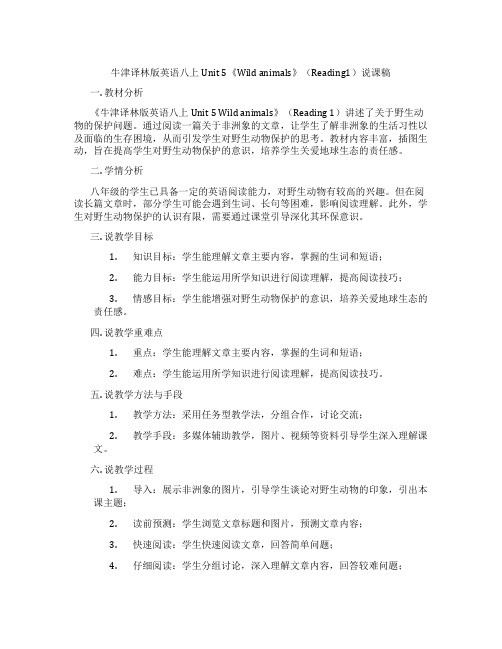
牛津译林版英语八上Unit 5《Wild animals》(Reading1)说课稿一. 教材分析《牛津译林版英语八上Unit 5 Wild animals》(Reading 1)讲述了关于野生动物的保护问题。
通过阅读一篇关于非洲象的文章,让学生了解非洲象的生活习性以及面临的生存困境,从而引发学生对野生动物保护的思考。
教材内容丰富,插图生动,旨在提高学生对野生动物保护的意识,培养学生关爱地球生态的责任感。
二. 学情分析八年级的学生已具备一定的英语阅读能力,对野生动物有较高的兴趣。
但在阅读长篇文章时,部分学生可能会遇到生词、长句等困难,影响阅读理解。
此外,学生对野生动物保护的认识有限,需要通过课堂引导深化其环保意识。
三. 说教学目标1.知识目标:学生能理解文章主要内容,掌握的生词和短语;2.能力目标:学生能运用所学知识进行阅读理解,提高阅读技巧;3.情感目标:学生能增强对野生动物保护的意识,培养关爱地球生态的责任感。
四. 说教学重难点1.重点:学生能理解文章主要内容,掌握的生词和短语;2.难点:学生能运用所学知识进行阅读理解,提高阅读技巧。
五. 说教学方法与手段1.教学方法:采用任务型教学法,分组合作,讨论交流;2.教学手段:多媒体辅助教学,图片、视频等资料引导学生深入理解课文。
六. 说教学过程1.导入:展示非洲象的图片,引导学生谈论对野生动物的印象,引出本课主题;2.读前预测:学生浏览文章标题和图片,预测文章内容;3.快速阅读:学生快速阅读文章,回答简单问题;4.仔细阅读:学生分组讨论,深入理解文章内容,回答较难问题;5.小组活动:学生分组进行角色扮演,模拟文章中的场景,加深对文章的理解;6.总结提升:教师引导学生总结文章主题,谈论野生动物保护的重要性;7.作业布置:学生课后写一篇关于我国野生动物保护的文章。
七. 说板书设计板书设计如下:1.课题:Unit 5 Wild animals2.阅读文章:African Elephants3.生词短语:–wildlife protection–survival–conservation–poaching–habitat destruction4.文章主题:关爱野生动物,保护地球生态八. 说教学评价1.课堂参与度:观察学生在课堂上的发言和讨论情况;2.阅读理解:检查学生回答问题的准确性;3.作业完成情况:评估学生课后作业的质量。
新译林牛津版初中英语八年级上册Unit 5 Wild animals Period 2 Reading 1优质课公开课教案
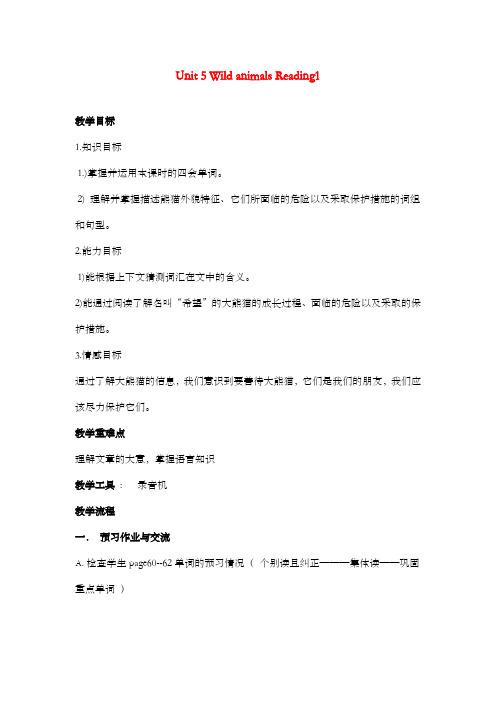
Unit 5 Wild animals Reading1教学目标1.知识目标1.)掌握并运用本课时的四会单词。
2) 理解并掌握描述熊猫外貌特征、它们所面临的危险以及采取保护措施的词组和句型。
2.能力目标1)能根据上下文猜测词汇在文中的含义。
2)能通过阅读了解名叫“希望”的大熊猫的成长过程、面临的危险以及采取的保护措施。
3.情感目标通过了解大熊猫的信息,我们意识到要善待大熊猫,它们是我们的朋友,我们应该尽力保护它们。
教学重难点理解文章的大意,掌握语言知识教学工具: 录音机教学流程一.预习作业与交流A.检查学生page60--62单词的预习情况(个别读且纠正———集体读——巩固重点单词)B. 重要词组1. 熊猫宝宝2. 看上去像一只白鼠3. 在4岁的时候4. 长成一只健康的大熊5. 在起初6. 吃竹笋7. 达到一天14个小时8. 叫她希望9 在将来10. 在野外生存11. 砍伐森林12. 处于危险中13. 采取以下的措施14. 鼓励……去做……15. 独自16. 把……带走17.第一次走出她的家18. 无处可生存19. 为……而杀……(学生的预习作业,课前已经在文中找出,帮助学生在预习时理解课文)(校对答案,不做词组的讲解——集体朗读——要求学生快速记忆——抽学生或小组、集体背诵)C .完成并检查page 61 中part B 的练习Millie Is reading a report, but there are some words she does not know.Le t’s help Millie match these words. Open your books and turn to page 61 to finis h part B.二.教学展示与探究:Part One Pre-readingStep 1 Guessing gameToday we are going to learn Unit 4 Wild animals Reading.We learned many wild animals, such as tigers, bears, kangaroos…First, let’s play a game called ‘guessing game’I’ll describe one kind of animals, please tell me what it is at once.It is a sea animal and looks like a large fish. It is very clever and often plays some games for us in the zoo.Yes, it’s a dolphin.It’s a heavy wild animal with thick fur and sharp paws. It can walk upright.Yes, it’s a bear.It’s the king of the animal world. It has yellow fur and black stripes on its body. Yes, it’s a tiger.It jumps with its baby in its pocket. You can see it in Australia.Yes, it’s a kangaroo.It lives in China. It is black and white. Its favorite food is bamboo shoots and leaves. Yes, it’s a giant panda.Step 2 PracticeNow, let’s have a discussion.Which aniaml do you like best? Why?Which animal do you like least? Why?Part Two While-readingStep 1 PresentationI like giant pandas best. Because I think they are beautiful black-and- white animals. They are very lovely, quiet and peaceful.Today I will show you a passa ge about a giant panda called ‘Xi Wang’.Step 2 listening and do T or F.Now, let’s listen to the tape .Write a ‘ T ’if the sentence is true. Write an ‘ F ’if the sentence is false.1.When the writer saw Xi Wang, she weighed only 10 kilograms. ( F )2.When she was 4 months old , she started to go outside for the first time. ( T )3.Eight months later, she weighed 35 kilograms. ( T )4.Xi Wang drank her mother's milk for up to 4 hours a day at the very beginning.( F )5.Giant pandas have no problems . ( F )6.Farmers kill them for their fur. ( T )7.Making bigger reserves for giant pandas will help to protect them. ( T )8.Giant pandas will live better if we do nothing for them. ( F )Step 3 ReadingWe can divide the passage into three parts.。
八年级英语上册 Unit 5 Wild animals Study skills教案 新牛津版
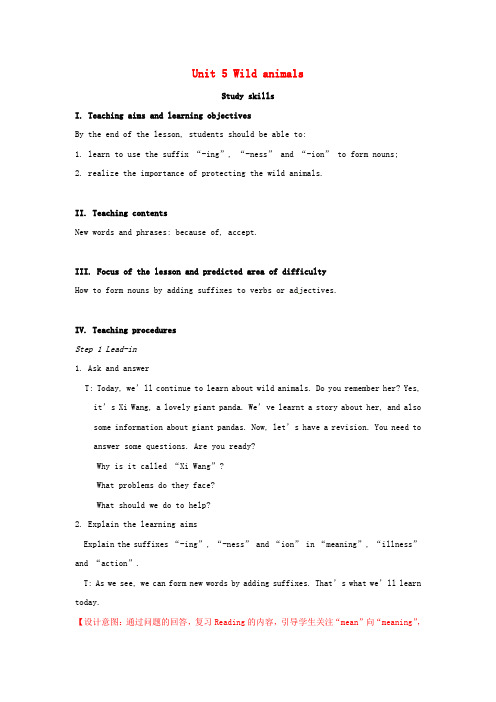
Unit 5 Wild animalsStudy skillsI. Teaching aims and learning objectivesBy the end of the lesson, students should be able to:1. learn to use the suffix “-ing”, “-ness” and “-ion” to form nouns;2. realize the importance of protecting the wild animals.II. Teaching contentsNew words and phrases: because of, accept.III. Focus of the lesson and predicted area of difficultyHow to form nouns by adding suffixes to verbs or adjectives.IV. Teaching proceduresStep 1 Lead-in1. Ask and answerT: Today, we’ll continue to learn about wild animals. Do you remember her? Yes, it’s Xi Wang, a lovely giant panda. We’ve learnt a story about her, and also some information about giant pandas. Now, let’s have a revision. You need to answer some questions. Are you ready?Why is it called “Xi Wang”?What problems do they face?What should we do to help?2. Explain the learning aimsExplain the suffixes “-ing”, “-ness”and “ion”in “meaning”, “illness”and “action”.T: As we see, we can form new words by adding suffixes. That’s what we’ll learn today.【设计意图:通过问题的回答,复习Reading的内容,引导学生关注“mean”向“meaning”,“ill”向“illness”,“ac t”向“action”的转化,引出本课时的学习目标。
牛津译林版八年级上册Unit 5《Wild animals》(Reading 1)教学设计

牛津译林版八年级上册Unit 5《Wild animals》(Reading 1)教学设计一. 教材分析《牛津译林版八年级上册Unit 5 Wild animals》的Reading 1主要介绍了大熊猫的保护以及人们为了保护大熊猫所做出的努力。
文章以故事的形式展开,让学生在了解大熊猫的同时,也能感受到人与自然和谐共生的重要性。
通过本课的学习,学生可以提高自己的阅读理解能力,学会珍惜和保护动物。
二. 学情分析八年级的学生已经具备了一定的英语基础,对于故事性的文章兴趣较高。
但部分学生在阅读理解上还存在一定的困难,需要教师的引导和帮助。
此外,学生对于野生动物的保护意识有待提高。
三. 教学目标1.知识目标:学生能够掌握文章中的关键词汇和句型,理解文章的主旨大意。
2.能力目标:学生能够运用所学知识进行阅读理解和口语表达。
3.情感目标:学生能够增强对野生动物的保护意识,培养与自然和谐共生的观念。
四. 教学重难点1.重点:学生能够掌握文章中的关键词汇和句型,理解文章的主旨大意。
2.难点:学生能够运用所学知识进行阅读理解和口语表达,提高对野生动物的保护意识。
五. 教学方法1.任务型教学法:通过设置各种任务,引导学生积极参与课堂活动,提高学生的阅读理解和口语表达能力。
2.情境教学法:创设各种情境,让学生在真实的语境中学习和使用英语。
3.情感教学法:通过文章的学习,引导学生关注野生动物的保护,培养学生的环保意识。
六. 教学准备1.教师准备:提前熟悉教材,了解文章的内容和结构,准备相关的教学材料和课件。
2.学生准备:预习文章,了解文章的大致内容,查阅生词。
七. 教学过程1.导入(5分钟)教师通过展示一些关于野生动物的图片,引导学生谈论野生动物,激发学生的学习兴趣。
然后,教师简要介绍大熊猫的特点,引出本课的主题。
2.呈现(10分钟)教师快速呈现文章的标题和图片,让学生猜测文章的内容。
然后,教师朗读文章,学生跟读并注意生词的发音。
牛津译林版八年级上册Unit 5《Wild animals》(Grammar 1)教学设计
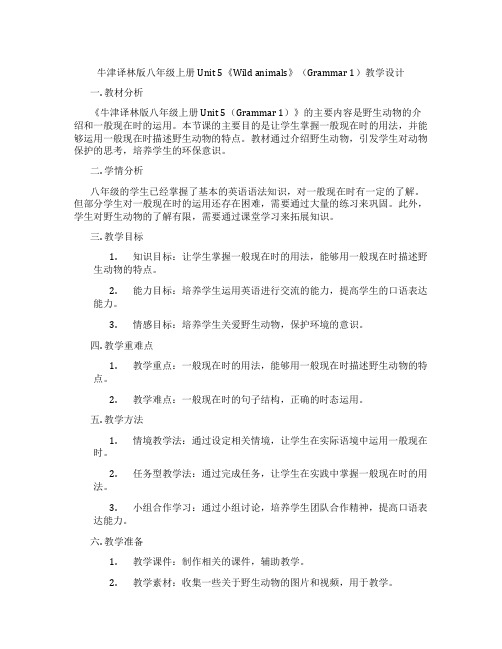
牛津译林版八年级上册Unit 5《Wild animals》(Grammar 1)教学设计一. 教材分析《牛津译林版八年级上册Unit 5(Grammar 1)》的主要内容是野生动物的介绍和一般现在时的运用。
本节课的主要目的是让学生掌握一般现在时的用法,并能够运用一般现在时描述野生动物的特点。
教材通过介绍野生动物,引发学生对动物保护的思考,培养学生的环保意识。
二. 学情分析八年级的学生已经掌握了基本的英语语法知识,对一般现在时有一定的了解。
但部分学生对一般现在时的运用还存在困难,需要通过大量的练习来巩固。
此外,学生对野生动物的了解有限,需要通过课堂学习来拓展知识。
三. 教学目标1.知识目标:让学生掌握一般现在时的用法,能够用一般现在时描述野生动物的特点。
2.能力目标:培养学生运用英语进行交流的能力,提高学生的口语表达能力。
3.情感目标:培养学生关爱野生动物,保护环境的意识。
四. 教学重难点1.教学重点:一般现在时的用法,能够用一般现在时描述野生动物的特点。
2.教学难点:一般现在时的句子结构,正确的时态运用。
五. 教学方法1.情境教学法:通过设定相关情境,让学生在实际语境中运用一般现在时。
2.任务型教学法:通过完成任务,让学生在实践中掌握一般现在时的用法。
3.小组合作学习:通过小组讨论,培养学生团队合作精神,提高口语表达能力。
六. 教学准备1.教学课件:制作相关的课件,辅助教学。
2.教学素材:收集一些关于野生动物的图片和视频,用于教学。
3.练习题:准备一些关于一般现在时的练习题,用于巩固所学知识。
七. 教学过程1.导入(5分钟)通过展示一些野生动物的图片,引导学生谈论自己喜欢的动物,从而引入本节课的主题。
2.呈现(10分钟)介绍一般现在时的概念和用法,用课件展示一般现在时的句子结构。
同时,通过举例说明一般现在时如何描述野生动物的特点。
3.操练(15分钟)让学生分组,每组选择一种野生动物,用一般现在时描述该动物的特点。
牛津译林版英语八上Unit 5《Wild animals》(Reading1)教学设计
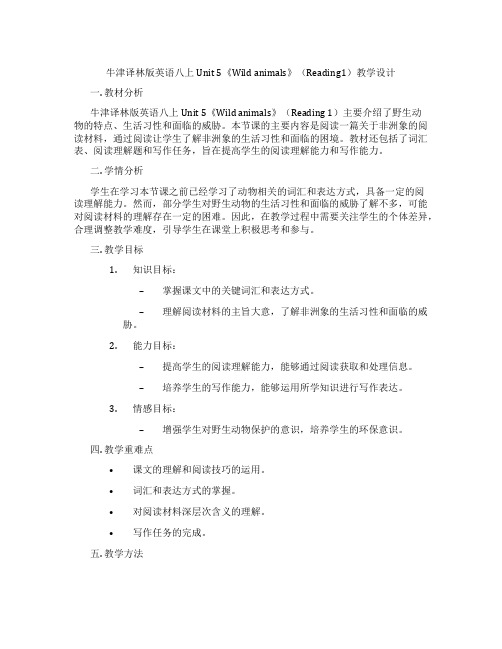
牛津译林版英语八上Unit 5《Wild animals》(Reading1)教学设计一. 教材分析牛津译林版英语八上Unit 5《Wild animals》(Reading 1)主要介绍了野生动物的特点、生活习性和面临的威胁。
本节课的主要内容是阅读一篇关于非洲象的阅读材料,通过阅读让学生了解非洲象的生活习性和面临的困境。
教材还包括了词汇表、阅读理解题和写作任务,旨在提高学生的阅读理解能力和写作能力。
二. 学情分析学生在学习本节课之前已经学习了动物相关的词汇和表达方式,具备一定的阅读理解能力。
然而,部分学生对野生动物的生活习性和面临的威胁了解不多,可能对阅读材料的理解存在一定的困难。
因此,在教学过程中需要关注学生的个体差异,合理调整教学难度,引导学生在课堂上积极思考和参与。
三. 教学目标1.知识目标:–掌握课文中的关键词汇和表达方式。
–理解阅读材料的主旨大意,了解非洲象的生活习性和面临的威胁。
2.能力目标:–提高学生的阅读理解能力,能够通过阅读获取和处理信息。
–培养学生的写作能力,能够运用所学知识进行写作表达。
3.情感目标:–增强学生对野生动物保护的意识,培养学生的环保意识。
四. 教学重难点•课文的理解和阅读技巧的运用。
•词汇和表达方式的掌握。
•对阅读材料深层次含义的理解。
•写作任务的完成。
五. 教学方法1.任务型教学法:通过设定具有挑战性的任务,激发学生的学习兴趣,培养学生独立思考和合作交流的能力。
2.情境教学法:创设真实、生动的情境,使学生在实际情境中学习和运用英语。
3.交际法:通过师生互动、生生互动,提高学生的口头表达能力。
4.启发式教学法:引导学生主动探索,发现问题,培养学生的自主学习能力。
六. 教学准备1.教师准备:–熟悉教材,明确教学目标和要求。
–准备相关的教学资源和素材。
2.学生准备:–预习课文,提前了解课文内容。
–准备笔记本,记录课堂笔记。
七. 教学过程1.导入(5分钟)–教师通过提问方式引导学生回顾已学的动物相关知识,激发学生的学习兴趣。
牛津译林版英语八上Unit 5《Wild animals》(Grammar)教学设计

牛津译林版英语八上Unit 5《Wild animals》(Grammar)教学设计一. 教材分析牛津译林版英语八上Unit 5《Wild animals》主要介绍了一些野生动物,包括老虎、狮子、熊、大象等。
本单元主要让学生掌握一般现在时的被动语态和一般过去时的被动语态,以及如何运用这些时态描述野生动物的特点和习性。
此外,本单元还包括一些关于野生动物的保护和濒危问题,旨在提高学生的环保意识。
二. 学情分析学生在学习本单元前,已经掌握了动词的现在时态和过去时态,以及一些基本的野生动物知识。
但部分学生对英语语法的学习仍有一定难度,尤其是对被动语态的运用。
因此,在教学过程中,需要关注学生的个体差异,针对不同学生的学习需求进行引导和帮助。
三. 教学目标1.能熟练运用一般现在时和一般过去时的被动语态描述野生动物的特点和习性。
2.能听懂、会说、会读、会写与野生动物相关的词汇和句子。
3.提高学生的环保意识,增强对野生动物的保护意识。
4.培养学生的合作能力和观察能力。
四. 教学重难点1.一般现在时和一般过去时的被动语态的运用。
2.野生动物相关词汇的掌握和运用。
3.对文本内容的理解和运用。
五. 教学方法1.任务型教学法:通过设定各种任务,让学生在实践中学习和运用语言。
2.情境教学法:创设各种情境,让学生在真实的环境中学习和运用语言。
3.合作学习法:鼓励学生分组合作,共同完成任务,培养团队精神。
4.观察法:引导学生观察野生动物的特点和习性,提高观察能力。
六. 教学准备1.教材、课件和教学资源。
2.野生动物的图片、视频等素材。
3.练习题和测试题。
4.分组合作的任务单。
七. 教学过程1.导入(5分钟)利用图片、视频等素材,引导学生谈论他们所知道的野生动物,激发学生的学习兴趣。
2.呈现(10分钟)展示教材中的图片和文字,引导学生观察和描述野生动物的特点和习性。
同时,引入一般现在时和一般过去时的被动语态。
3.操练(15分钟)分组进行角色扮演,让学生运用所学的被动语态描述野生动物的特点和习性。
牛津译林版英语八上Unit 5《Wild animals》(integrated skills)教学
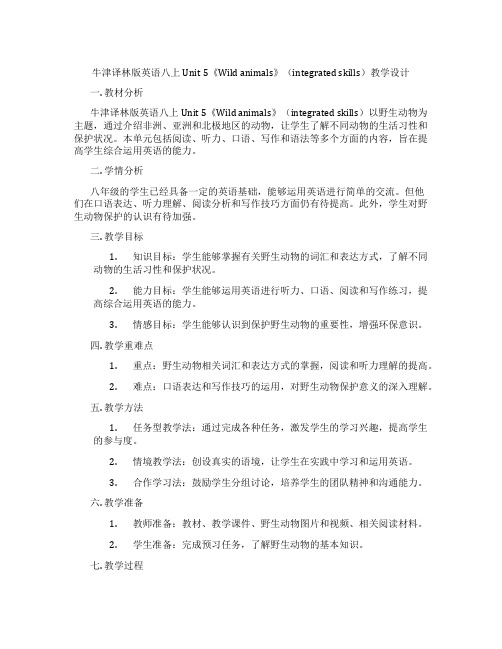
牛津译林版英语八上Unit 5《Wild animals》(integrated skills)教学设计一. 教材分析牛津译林版英语八上Unit 5《Wild animals》(integrated skills)以野生动物为主题,通过介绍非洲、亚洲和北极地区的动物,让学生了解不同动物的生活习性和保护状况。
本单元包括阅读、听力、口语、写作和语法等多个方面的内容,旨在提高学生综合运用英语的能力。
二. 学情分析八年级的学生已经具备一定的英语基础,能够运用英语进行简单的交流。
但他们在口语表达、听力理解、阅读分析和写作技巧方面仍有待提高。
此外,学生对野生动物保护的认识有待加强。
三. 教学目标1.知识目标:学生能够掌握有关野生动物的词汇和表达方式,了解不同动物的生活习性和保护状况。
2.能力目标:学生能够运用英语进行听力、口语、阅读和写作练习,提高综合运用英语的能力。
3.情感目标:学生能够认识到保护野生动物的重要性,增强环保意识。
四. 教学重难点1.重点:野生动物相关词汇和表达方式的掌握,阅读和听力理解的提高。
2.难点:口语表达和写作技巧的运用,对野生动物保护意义的深入理解。
五. 教学方法1.任务型教学法:通过完成各种任务,激发学生的学习兴趣,提高学生的参与度。
2.情境教学法:创设真实的语境,让学生在实践中学习和运用英语。
3.合作学习法:鼓励学生分组讨论,培养学生的团队精神和沟通能力。
六. 教学准备1.教师准备:教材、教学课件、野生动物图片和视频、相关阅读材料。
2.学生准备:完成预习任务,了解野生动物的基本知识。
七. 教学过程1.导入(5分钟)利用图片和视频展示不同野生动物,引导学生谈论自己喜欢的动物,激发学生的学习兴趣。
2.呈现(10分钟)教师展示课文标题《Wild animals》,引导学生预测文章内容。
然后逐段呈现课文,让学生注意生词和短语。
3.操练(15分钟)学生分组进行角色扮演,模拟课文中的对话,巩固所学词汇和表达方式。
牛津译林版英语八上Unit 5《Wild animals》(Welcome)教学设计

牛津译林版英语八上Unit 5《Wild animals》(Welcome)教学设计一. 教材分析牛津译林版英语八上Unit 5的主题是“Wild animals”,本节课的主要内容是让学生掌握关于野生动物的词汇和表达方式,同时通过讨论和思考,提高学生对动物保护的意识。
教材中包含了丰富的图片、词汇和对话,为教学提供了很好的素材。
二. 学情分析学生在进入八年级时已经具备了一定的英语基础,能够进行简单的英语交流。
但是,对于一些较为复杂的野生动物的词汇和表达方式可能还比较陌生。
因此,在教学过程中,需要引导学生逐步掌握新词汇,并通过实际操作和练习,提高学生的语言运用能力。
三. 教学目标1.知识目标:让学生掌握关于野生动物的词汇和表达方式,了解动物保护的重要性。
2.能力目标:通过讨论和思考,提高学生对动物保护的意识,培养学生运用英语进行交流的能力。
3.情感目标:培养学生热爱大自然,关爱野生动物的情感。
四. 教学重难点1.重点:让学生掌握关于野生动物的词汇和表达方式。
2.难点:如何引导学生通过实际操作和练习,运用所学知识进行交流和讨论。
五. 教学方法1.任务型教学法:通过设定各种任务,让学生在实际操作中运用所学知识。
2.情境教学法:通过创设各种情境,让学生在真实的环境中学习和使用英语。
3.小组合作学习:通过小组讨论和交流,提高学生的参与度和合作能力。
六. 教学准备1.教学课件:制作包含野生动物图片、词汇和对话的教学课件。
2.教学材料:准备与野生动物相关的故事、文章等阅读材料。
3.教学设备:多媒体投影仪、音响设备等。
七. 教学过程1.导入(5分钟)利用多媒体展示一些野生动物的图片,引导学生谈论这些动物的特点和生活习性。
2.呈现(10分钟)通过课件展示本节课的主要词汇和表达方式,如:tiger, lion, panda, giraffe等,同时呈现相应的句子,让学生跟读并进行模仿。
3.操练(10分钟)将学生分成小组,每组选择一种野生动物,用英语介绍这种动物的特点和生活习性。
牛津译林版英语八年级上册Unit5Wildanimals综合技能课教学设计
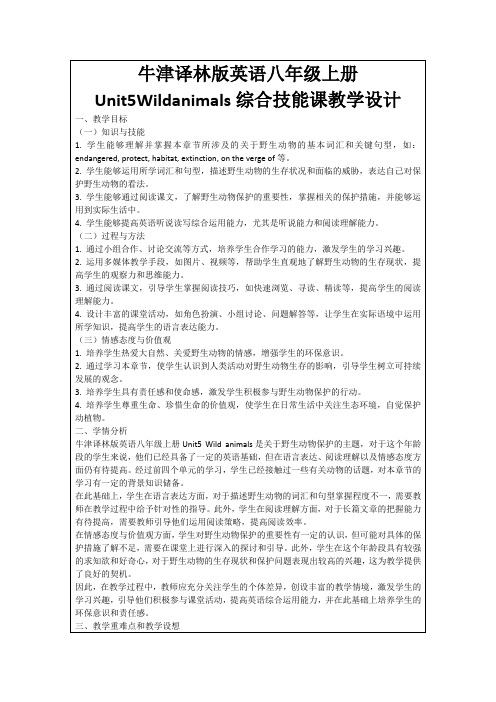
1.教师带领学生一起学习本章节的生词和短语,如:endangered, protect, habitat, extinction等,并结合图片进行讲解,帮助学生理解记忆。
2.教师通过示例句型和课文内容,讲解野生动物保护的相关句型,如:
- Many wild animals are on the verge of extinction.
2.阅读理解:阅读一篇关于野生动物保护的文章,完成相关阅读理解题目。要求学生在阅读过程中注意运用课堂所学的阅读策略,提高阅读效率。
3.课后调查:以小组为单位,选择一种本地的野生动物,进行调查了解,包括其生活习性、生存现状、面临的问题等。将调查结果整理成一份报告,并在课堂上进行分享。
4.视频观看:观看一部关于野生动物保护的纪录片,了解世界各地野生动物的生存状况和保护措施。观看后,写下自己的观后感,不少于50词。
- What measures can we take to protect this animal?
2.各小组进行讨论,整理讨论成果,准备进行课堂分享。
3.教师巡回指导,关注学生的讨论过程,适时给予提示和建议。
(四)课堂练习,500字
1.教师设计一系列练习题,包括词汇填空、句型翻译、阅读理解等,检验学生对本节课所学知识的掌握程度。
3.学生能够通过阅读课文,了解野生动物保护的重要性,掌握相关的保护措施,并能够运用到实际生活中。
4.学生能够提高英语听说读写综合运用能力,尤其是听说能力和阅读理解能力。
(二)过程与方法
1.通过小组合作、讨论交流等方式,培养学生合作学习的能力,激发学生的学习兴趣。
2.运用多媒体教学手段,如图片、视频等,帮助学生直观地了解野生动物的生存现状,提高学生的观察力和思维能力。
新译林牛津版初中英语八年级上册Unit 5 Wild animals reading 1优质课公开课教案
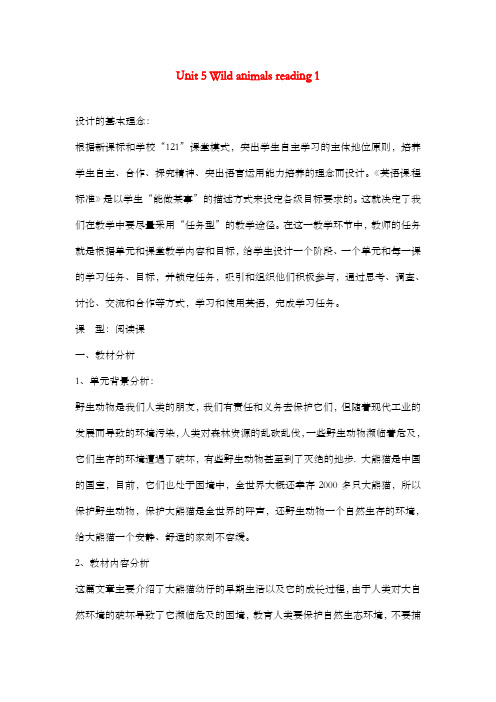
Unit 5 Wild animals reading 1设计的基本理念:根据新课标和学校“121”课堂模式,突出学生自主学习的主体地位原则,培养学生自主、合作、探究精神、突出语言运用能力培养的理念而设计。
《英语课程标准》是以学生“能做某事”的描述方式来设定各级目标要求的。
这就决定了我们在教学中要尽量采用“任务型”的教学途径。
在这一教学环节中,教师的任务就是根据单元和课堂教学内容和目标,给学生设计一个阶段、一个单元和每一课的学习任务、目标,并锁定任务,吸引和组织他们积极参与,通过思考、调查、讨论、交流和合作等方式,学习和使用英语,完成学习任务。
课型:阅读课一、教材分析1、单元背景分析:野生动物是我们人类的朋友,我们有责任和义务去保护它们,但随着现代工业的发展而导致的环境污染,人类对森林资源的乱砍乱伐,一些野生动物濒临着危及,它们生存的环境遭遇了破坏,有些野生动物甚至到了灭绝的地步. 大熊猫是中国的国宝,目前,它们也处于困境中,全世界大概还幸存2000多只大熊猫,所以保护野生动物,保护大熊猫是全世界的呼声,还野生动物一个自然生存的环境,给大熊猫一个安静、舒适的家刻不容缓。
2、教材内容分析这篇文章主要介绍了大熊猫幼仔的早期生活以及它的成长过程,由于人类对大自然环境的破坏导致了它濒临危及的困境,教育人类要保护自然生态环境,不要捕杀野生动物,并要采取一些保护大熊猫的措施,结合课文,让学生意识到生态环境对动物的重要性,联系实际,分析我们目前当地生态坏境,一些环境污染影响着我们的生活质量,让学生明白保护我们的生存环境的重要性,让学生在实际中能够自觉保护我们的生存环境。
3、教材重点、难点教材重点:(1)重点词组:be born, look like, at four months old, not…at all, in the beginning, look after herself, face serious problems, live on, as a result, in danger, take action, right away, at birth. (2)重点句型:When Xi Wang was born, she weighed just 100 grams and looked like a white mouse. Eight months later, she was not a small baby ant more.Giant pandas live mainly on a special kind of bamboo.As a result, pandas may not have a place to live or food to eat.If we do nothing, soon there may be none left!(3)重点语法:动词不定式的正确使用。
牛津英语(新)区级公开课Let’s protect the wild animals8AUnit6 comic strip课件2 陈丹
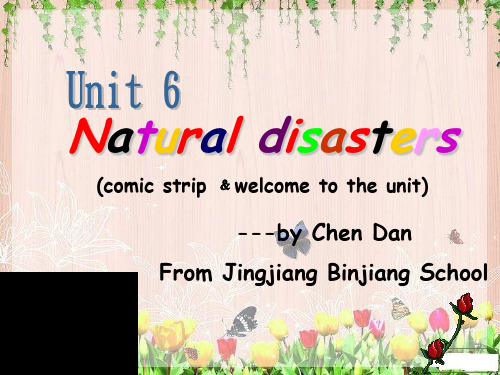
Task One: talking about some common weather
What’s the weather like?
sunny
Task One: talking about some common weather
What’s the weather like?
Typhoon
3. Which of the following is
right during a typhoon?
A. To close all the doors. B. To hide under a big tree.
C. To stay on the top floor.
Typhoon
Task Four What shall we do when we are facing natural disasters?
Round Three
Rushing to answer
If you know the answer, put up your hands as quickly as you can.
4
typhoon
5
rainstorm
6
thunder
wash the flood village away
冲走村庄
caused by natural forces
自然界的力量引发
start a lightning big fire 引发火灾
/'æ ksidənt/ caused by people 撞上一棵树 人的因素引发
Task Three Talking about some other kinds of natural disasters
八年级英语上册 Unit 5 Wild animals(第1课时)教案 (新版)牛津版-(新版)牛津
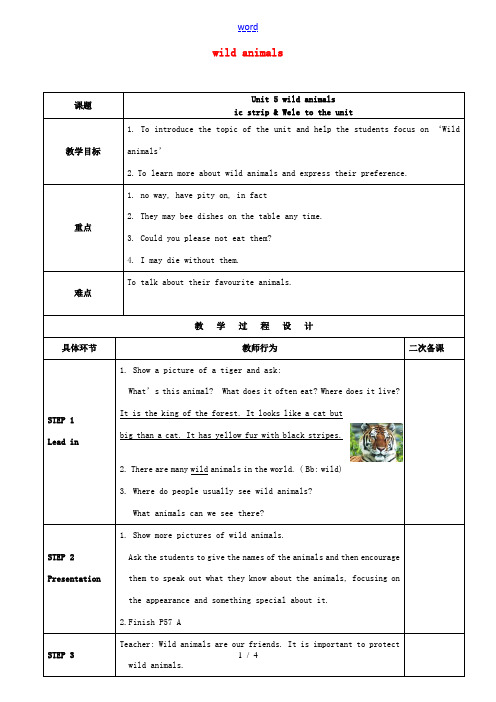
wild animals课题Unit 5 wild animalsic strip & Wele to the unit教学目标1. To introduce the topic of the unit and h elp the students focus on ‘Wild animals’2.To learn more about wild animals and express their preference.重点1. no way, have pity on, in fact2. They may bee dishes on the table any time.3. Could you please not eat them?4. I may die without them.难点To talk about their favourite animals.教学过程设计具体环节教师行为二次备课STEP 1 Lead in 1. Show a picture of a tiger and ask:What’s this animal? What does it often eat? Where does it live? It is the king of the forest. It looks like a cat butbig than a cat. It has yellow fur with black stripes.2. There are many wild animals in the world. ( Bb: wild)3. Where do people usually see wild animals?What animals can we see there?STEP 2 Presentation 1. Show more pictures of wild animals.Ask the students to give the names of the animals and then encourage them to speak out what they know about the animals, focusing on the appearance and something special about it.2.Finish P57 ATeacher: Wild animals are our friends. It is important to protectGuessing game Let’s check how much you know about wild animals. Do you know them?Play a guessing game.Write the names on pieces of papers and then invite some of the more able students to choose and say something of the animals (Tomake it easier, ask the students to use the first person). The otherstudents should listen carefully and guess what animal it is.1. Bear: I am strong. Sometimes, I eat people. But if I find the peopledied, I don’t eat them. Who am I?2. Kangaroo: I have a pocket. My baby sleeps in my pocket. Who amI?3. Squirrel: I have a long and soft tail. I live in the tree. Whoam I?4. Giant Panda: I have black eyes and four black paws. I like eatingbamboo shoots. I am very lovely. Who am I?5. Dolphin: I like swimming. I can do different kinds of swimmingshows. Many people bring their children to watch my shows. Whoam I?6. Tiger: I am the king of the animals. I look like a cat but I’mbigger than a cat. Usually, I have yellow fur and black stripes.Who am I?STEP 4 Practice P57 B1. T: Millie and her classmates are talking about their favouritewild animals.Let’s listen to their conversation and find their favourite wild animals.Simon KittyPeter & Millie。
《牛津初中英语》8A__Unit_4_Wild_animals教案新部编本(2)

精选教课教课设计设计| Excellent teaching plan教师学科教课设计[ 20–20学年度第__学期]任教课科: _____________任教年级: _____________任教老师: _____________xx市实验学校《牛津初中英》 8A Unit 4 Wild animalsComic strip& Welcome to the unit一、教课目1 认识内容,掌握要点及初步认识if 句型的用法2.熟习学更多相关野生物的二、教课重点学生表达物的爱好三、教课流程Step1 Comic stripHobo and Eddie have a new problem now. Listen to the tape and answer the following questions.1 What does Hobo want to do?2 Is Eddie willing to share his food?Language points:look delicioustalk to/with sblook after/ take care ofAsk students to pay attention to ‘ if ’ clausesStep2 VocabulariesAsk students to look at the pictures and learn new words about wild animals. bear dolphin giant panda kangaroo squirrel tigerStep3 Guessing gamesLet students paly a guessing gane to engage them.One student describes and th e other guess ‘ Whatanimal is it? ’Step 4 Make a surveyAsk stuents to work in pairs. Complete the survey form on P59Step5 DiscussionA:Which animal do you like best?B:I like ⋯⋯best.A:Why?B:Because they are ⋯ ...A:Which animal do you like least?B:I like ⋯⋯ least.A: Why?B:Because they are ⋯ ...Step 6 HomeworkRemember all the words about wild animals and try to describe them.《牛津初中英》 8A Unit 4 Wild animals Reading1 一教课目1.知目1.)知并运用本的四会。
八年级英语上册 Unit 5 Wild animals(第5课时)Integrated skills教案 (新版)牛津版
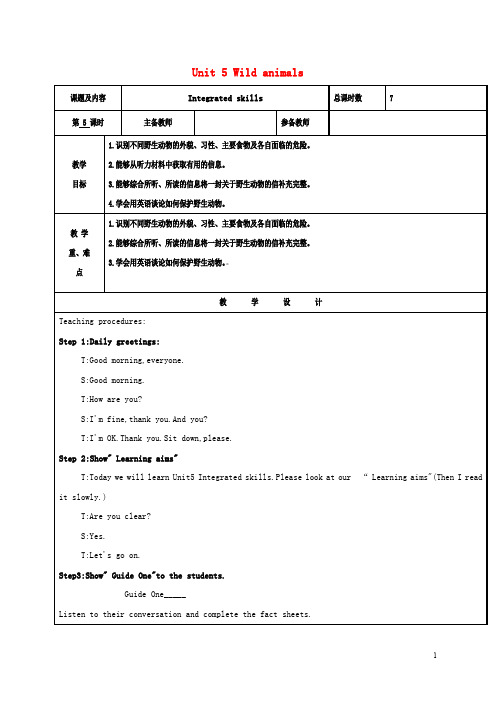
T:How are you?
S:I'm fine,thank you.And you?
T:I'm OK.Thank you.Sit down,please.
Step 2:Show"Learning aims"
T:Today we will learn Unit5 Integrated skills.Please look at our“Learning aims"(Then I read it slowly.)
Unit 5 Wild animals
课题及内容
Integrated skills
总课时数
7
第5课时
主备教师
参备教师
教学
目标
1.识别不同野生动物的外貌、习性、主要食物及各自面临的危险。
2.能够从听力材料中获取有用的信息。
3.能够综合所听、所读的信息将一封关于野生动物的信补充完整。
4.学会用英语谈论如何保护野生动物。
Step5:Show"Guide Three"to the students.
Guide Three____
1.Listen to the tape and repeat.
2.Help the students make some simple conversations.
Have a match!Who can do it best?
教学
重、难
点
1.识别不同野生动物的外貌、习性、主要食物及各自面临的危险。
2.能够综合所听、所读的信息如何保护野生动物。。
教学设计
Teaching procedures:
新牛津译林版六上《Unit 7 Protect the EarthD》教案(精品)
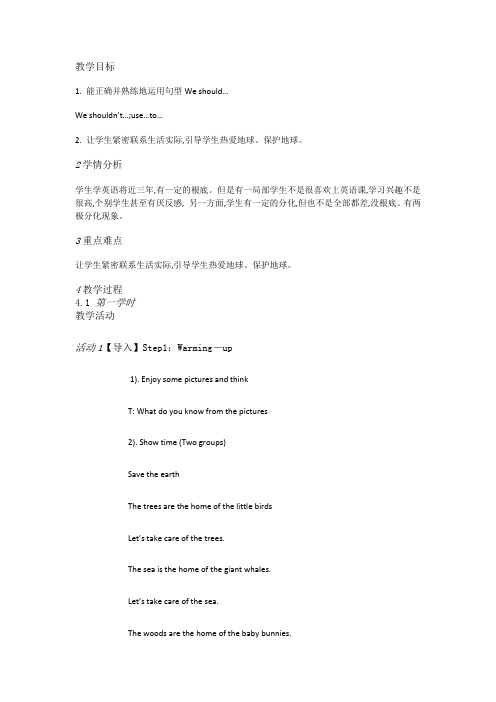
教学目标1. 能正确并熟练地运用句型We should…We shouldn’t…;use…to…2. 让学生紧密联系生活实际,引导学生热爱地球、保护地球。
2学情分析学生学英语将近三年,有一定的根底。
但是有一局部学生不是很喜欢上英语课,学习兴趣不是很高,个别学生甚至有厌反感, 另一方面,学生有一定的分化,但也不是全部都差,没根底。
有两极分化现象。
3重点难点让学生紧密联系生活实际,引导学生热爱地球、保护地球。
4教学过程4.1 第一学时教学活动活动1【导入】Step1:Warming-up1). Enjoy some pictures and thinkT: What do you know from the pictures2). Show time (Two groups)Save the earthThe trees are the home of the little birdsLet’s take care of the trees.The sea is the home of the giant whales.Let’s take c are of the sea.The woods are the home of the baby bunnies.Let’s take care of the woods.The swamp is the home of the alligator.Let’s take care of the swamp.Save the earth.Let’s all work together.(图片与诗歌导入课题,激发学生学习热情并能够积极参与保护地球的行动中来,从我做起。
)活动2【讲授】Step2:PresentationT: The earth is our home. Let’s protect the earth. Let’s save our home.Q: To protect the earth, what should we do (复习课文)Save waterPractice: Brainstorm1). Make sentences “ use … to…〞Work in groups (T/S以water 为例,然后小组合作操练wood, oil, coal etc. )How to reuse2). Discuss how to reuse water.save energy save trees Don’t use too much plastic.(进行有关环保的问答训练,师生、生生之间操练,复习课文。
牛津译林版八年级上册Unit5Wildanimals全国公开课一等奖
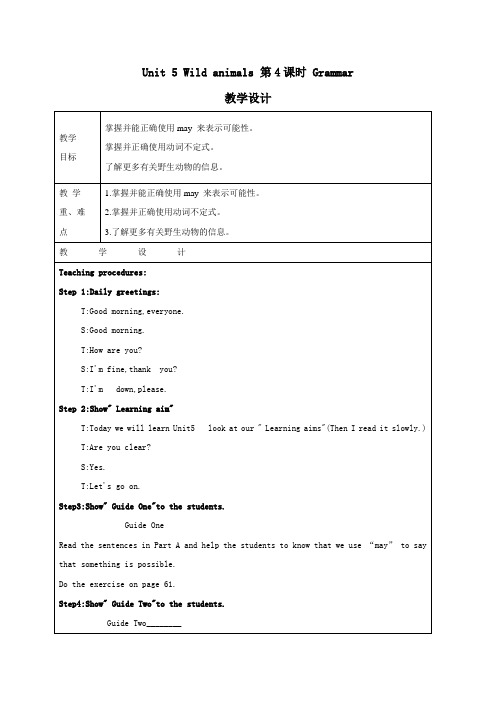
S:Yes.
T:Let's go on.
Step3:Show"Guide One"to the students.
Guide One
Read the sentencesin Part A and help the students to know that we use“may”to say that something is possible.
Do the exercise on page 61.
Step4:Show"Guide Two"to the students.
Guide Two________
Read the sentences in Part B and help the students to know that we use verbs and to-infinitives together.
Unit 5 Wild animals 第4课时 Gramma正确使用may来表示可能性。
掌握并正确使用动词不定式。
了解更多有关野生动物的信息。
教学
重、难
点
1.掌握并能正确使用may来表示可能性。
2.掌握并正确使用动词不定式。
3.了解更多有关野生动物的信息。
教学设计
Teaching procedures:
Do the exercise on page 62.
Let's have a match and see who can do it best.
Step5:Class Exercise (一)
用may 的适当形式填空(课课练P50 一)
Class Exercise (二)
八年级英语上册 Unit 5 Wild animals(第2课时)教案 (新版)牛津版-(新版)牛津
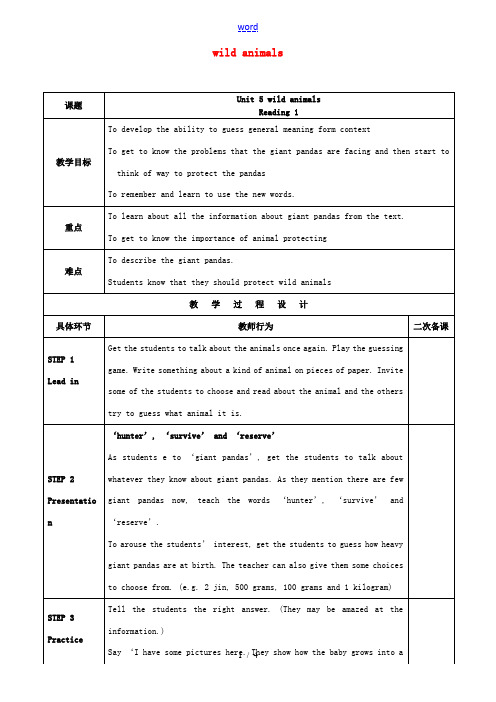
Practice
Tell the students the right answer. (They may be amazed at the information.)
Say ‘I have some pictures here. They show how the baby grows into agiant panda. Can you put them into the right order?’
Encourage farmers to leave the giant panda reserves.
STEP 8FinishingPart D
Hunters, farmers and some people did something bad to giant pandas. Get the students to say something to them.
6 months
/
8 months
Grow intoa healthy young giant pandas
12 months
/
20 months
Have tolook after her self
STEP 6
FinishingPart C
Get the students to finish Part C: the growth of Xi Wang. Look at the pictures and get the students to read the sentences here loudly. This will once again consolidate the students’ understanding of Xi Wang’s growth.
- 1、下载文档前请自行甄别文档内容的完整性,平台不提供额外的编辑、内容补充、找答案等附加服务。
- 2、"仅部分预览"的文档,不可在线预览部分如存在完整性等问题,可反馈申请退款(可完整预览的文档不适用该条件!)。
- 3、如文档侵犯您的权益,请联系客服反馈,我们会尽快为您处理(人工客服工作时间:9:00-18:30)。
Let’s protect the wild animals.
Teaching aim:
1 To review important words, phrases and sentences in this unit
2 To encourage students to say something about their familiar wild animals and the ways to protect wild animals.
3 To make students know the importance of protecting wild animals
Teaching steps:
Step1 Free talk and a guessing game
Ask students to enjoy the sound in the forest. Talk with students about something about the teacher’s favourite wild animals and let students guess what they are. Then ask students to say something about their favourite animals and let their classmates guess what they are .
Step 2 Visit the zoo
1 Show students a map of a zoo and tell them we will visit it today. Before visiting the zoo, let students do some exercises. The students who can do most of the exercises correctly can go to the zoo.
2 I will take students to visit three different parts of the zoo. In each part , I will give them different exercises.
Part1 When students visit the bird houses, they should say something about the birds and tell the birds about Zhalong Nature Reserve.
Part2 When students come to the Monkey Hill, they are asked to complete the notes with conditional sentences and because clause.
Part3 When students go to the Panda Hall, they will make a dialogue with the animal keeper about panda to talk about their appearance , ability, characters and danger and so on. Part4 After students visit their favourite wild animals, they will make a dialogue or give us a report about their favourite animals.
Step 3 watch a video and talk about wild animals’ problems If you are a wild animal. Now you meet some problems. What would you like to say to people? Please tell them your problems and your hopes.
Step4 Discussion
Encourage students to talk about how to protect wild animals.
Step5 Make a conclusion
Animals are our friends, so please be friendly to them. They are our family, so please love and care for them.
Let’s make it a peaceful world, and make it a better place for you and for me. Please remember if the buying stops, the killing can too!
Step 6 Homework
1 Review important phrases and sentences in unit4 and unit5.
2 Read more articles to learn more about wild animals and try your best to help them.。
